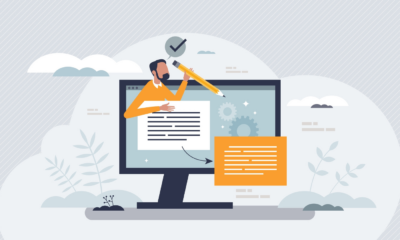Digital asset management software, often called DAMs, are marketing platforms that store, organize and make useful an organization’s entire library of digital assets. A DAM is the “single source of truth” where marketers can find every relevant version of the media assets (aka marketing asset management) that have been created for the brand — images, PDFs, photographs, audio, video and even virtual reality or other cutting-edge formats. The further benefit of a DAM is that these assets are appended with metadata that can provide information on anything the marketer might want to know before using the asset, such as whether the company owns the perpetual rights to use a photograph (and in what markets), whether the legal team has approved a video, and that an infographic or whitepaper has been checked to ensure it complies with the brand’s design standards.
Today, enterprises are using DAMs in a variety of ways. Marketing agencies might leverage DAM technology to help their customers maintain consistency across in-house content and creative developed by partners. B2B businesses might use DAMs differently, drawing on the benefits of a centralized hub for sales collateral and event marketing materials. DAMs are also being integrated with other technologies, especially content management systems (CMSs) and digital experience platforms (DXPs), to unify this marketing asset management with the ability to distribute digital content directly to the channels where they’re consumed.
Before the blossoming of software-as-a-service (SaaS), DAMs were installed software that resided on a company’s servers. But their utility has grown exponentially — especially for global and distributed organizations — now that most DAMs are cloud-based offerings.
This guide is for marketers who are looking to enhance their campaigns with digital assessment management technologies. Here’s what’s inside:
Estimated reading time: 8 minutes
Capabilities of digital asset management platforms
What should a DAM platform do and what are the ways that vendors differ from one another? The answer is fairly wide-reaching. Digital asset management platforms offer a wide range of capabilities ranging from legacy features like file management to emerging capabilities due to the advent of artificial intelligence and machine learning. Let’s look at those capabilities in more detail.
Workflow management
DAM systems differ in the extent of their workflow management capabilities. Some DAMs allow collaboration through @ tagging, while others have more full-fledged project management offerings. This functionality can help marketing teams, along with outside creative resources, communicate about changes while an asset is in the development phase or being updated.
Later in the process, they can allow for approvals to be obtained from brand managers, execs and the legal team, while some systems also facilitate asset distribution. These capabilities may be built into the core platform or be offered as an add-on or integration. Most DAMs are offered as SaaS and can be accessed from modern browsers on a variety of platforms, but some have developed native apps for mobile or other platforms.
File formats and handling
One area of differentiation involves the varying abilities of DAMs to manage a variety of file formats. Though most players say they support the most popular video, image and audio formats, if your workflow requires the use of a specialized format you will want to ensure the vendors you’re considering can fully support that format.
Asset conversion, editing and customization
Once an asset has been uploaded in a particular format, some DAM platforms allow downloading or distribution in other formats — with conversions happening on the fly. Some offer lightweight editing capabilities within the platform, though connections with common image editing sofware (Adobe Photoshop, Adobe Illustrator, etc.) are typically more useful.
Distribution and user permissions management
The content production supply chain can be long and complicated, involving many departments, agencies, freelancers and more. The ability to provide flexible permissions so that the right people have access to the right assets –– and only the right assets –– can be very valuable.
Within agencies, in particular, these capabilities can allow for offering clients/customers convenient self-service capabilities. The same dynamic can play out in large enterprises seeking to maintain a consistent brand message across geographies and verticals, where marketers and salespeople can help themselves to carefully-crafted materials like line sheets, production logs, catalogs, retail snapshots, etc.
Search and metadata
A DAM provider’s capabilities with regard to metadata and search are key to one of the most important benefits of a digital asset management system –– the ability to find assets after they’ve been created and filed away. Most providers now use artificial intelligence, either proprietary or through a partnership, for image and video recognition and tagging. A few years ago, the AI-tagging capabilities in many DAMs were nothing more than a gimmick, often creating more work than efficiencies. Now, however, these systems have grown in sophistication, in part because machine learning, by its very nature, improves as it’s fed more data. In addition, vendors are exploring ways to use these technologies to surface insights and automate content transformations based on usage patterns.
Get the daily newsletter digital marketers rely on.
Digital rights and corporate governance management
Most marketers license content — especially photos and videos — either from individual creators or from stock libraries. DAMs allow users to keep track of the specific license terms governing each piece of content, ensuring they’re not used in the wrong market, in an unapproved context or after the expiration of the license term.
Corporate governance of brand guidelines, as well as timelines associated with particular marketing campaigns, can also typically be managed with DAM functionality.
Reports and analytics
Analytics capabilities are what allow marketing leaders to trace the return on the investment made in the development of digital media. These functions also let marketers determine which assets are being used most often, and in what ways, so they can use those insights when planning for future content creation.
Data storage and security
The majority of DAM providers have partnered with Amazon Web Services or Google to host their software and their clients’ assets, and so depend on their partners’ geographical distribution, regular backups and adherence to security protocols. However, some players offer clients a variety of options for data hosting, something that’s likely to be appreciated by enterprises that operate in markets with strict data governance regulations.
Integrations
Since a DAM system is meant to be the central “single source of truth” repository for all of a brand’s assets, a key factor for a successful deployment will be whether or not it integrates well with the other tools in your martech stack. Vendors differ greatly in terms of the number and types of integrations they offer. Some are also beginning to specialize in serving a specific sector with unique integration needs, such as online retailers using product information management (PIM) systems.

Explore DAM solutions from vendors like Acquia, Widen, Cloudinary, MediaValet and more in the full MarTech Intelligence Report on digital asset management platforms.
What are the benefits of using a digital asset management (DAM) system?
Digital asset management systems can play a vital role in your marketing organization, unifying online and offline marketing channels and leading to more efficient marketing resource allocation.
The specific benefits of using a digital asset management platform include – but are not limited to – the following:
- Improved communication between in-house and freelance /contract workers. Some DAM vendors offer specially designed interfaces for external creatives to submit their content and collaborate on needed changes and required versioning. Content in the creation/approval process remains accessible only to those
involved at this stage, rather than being made available for deployment before it’s ready. - Improved distribution of assets to clients, partners or other outsiders. Some DAM vendors allow users to create “portals” customized for viewing and downloading by outside entities.
- More efficient utilization of existing resources. Appended metadata and search capabilities of DAMs enable marketers to more easily find the right image or another asset for a campaign, without spending tedious hours flipping from image to image or watching video after video. This also saves time and resources that are often spent recreating something similar to an existing asset, because it couldn’t be found or the user wasn’t aware of its
existence. - Increased efficiency in the workflow for internal approvals. Many DAM providers offer — either as part of core functionality or as an add-on — workflow or project management tools, which allow for smoother collaboration and transparent movement of an asset through an approval process.
- Speed the conversion of assets into different sizes, aspect ratios and file types for different marketing applications. Though a file is uploaded to the DAM system in a particular format, many systems allow for automatic or manual cropping or editing within the system, as well as the conversion of the asset to different sizes or file formats as they’re downloaded or distributed for use.
- Improved efficiency on the front end, in the creation of brand assets, and on the back end, in the distribution of those assets to various martech and ad tech systems. Many DAMs integrate with content creation software, like Adobe’s Creative Cloud, and also connect (either through native connectors or APIs) to systems that distribute content directly to the customer, such as ad servers, marketing automation platforms or website content management systems.
- Easier compliance with changing brand standards and licensing terms. DAMs allow for an expiration date to be set on assets, so they are no longer used after the licensing term for a particular asset expires. For example, if a contract with a particular celebrity spokesperson is not renewed, a DAM can take those assets out of circulation so they’re not used beyond the expiry date.
- Ease of presenting a more consistent brand face to the customer with an eye toward loyalty and retention. DAMs make it easier to enforce brand standards and distribute digital content so every customer interaction reinforces the brand values marketers intend to convey. This is one of the key advantages of a DAM at a time where the number of devices and media outlets is larger than ever, making it more difficult to maintain consistency among the assets designed for consumption in various places.
- Ability to quantify the usage of each individual digital asset, and therefore track ROI on the cost of creation and distribution. DAMs enable marketers to track the distribution and efficacy of marketing assets, which allows them to invest more in the most cost-effective content creation and distribution methods. Some systems are able to automatically track this data, while oth
















![YouTube Ad Specs, Sizes, and Examples [2024 Update] YouTube Ad Specs, Sizes, and Examples](https://articles.entireweb.com/wp-content/uploads/2024/06/YouTube-Ad-Specs-Sizes-and-Examples.jpg)
















You must be logged in to post a comment Login